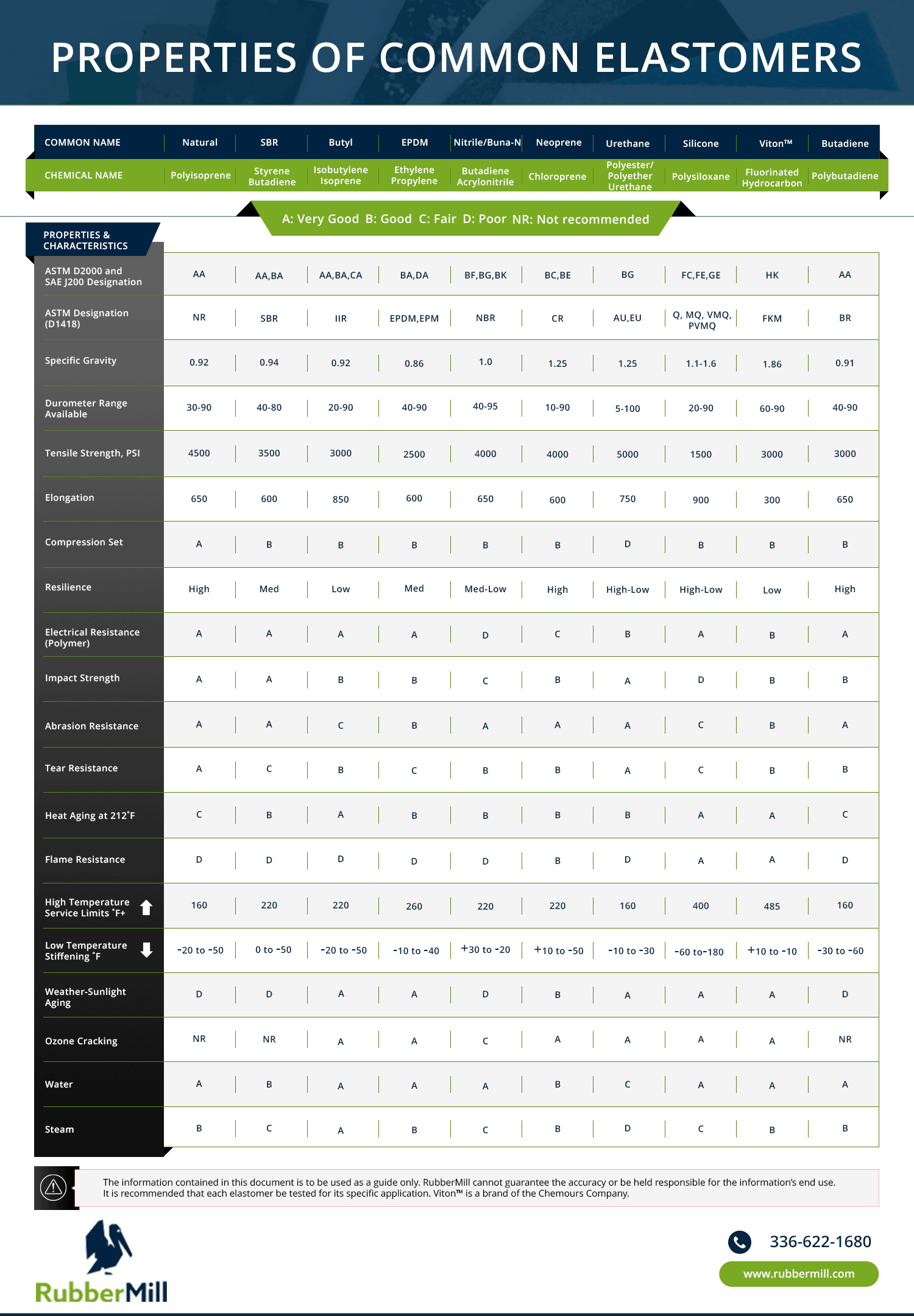What Are Elastomers?
Elastomers are synthetic or natural materials capable of repeated stretching without losing their original shape. Natural rubber is one of the most widely known elastomers. Choosing the best elastomeric material for your industrial needs requires understanding the different types of elastomers on the market. Below are common elastomers and how they fall into various categories, with some overlap based on their appropriate applications.
These general-purpose elastomers are some of the most common in use today:
- Neoprene
- Natural Rubber
- SBR
- Silicone Rubber
Examples of high-temperature elastomers include:
- Neoprene
- Viton®
- Silicone Rubber
- EPDM
Low-temperature elastomers include:
- Silicone Rubber
- Butadiene
- Butyl
- Natural Rubber
High-performance engineered elastomers, such as neoprene and butadiene, have a higher price point and offer greater durability in harsh operating environments. These oil- and hydrocarbon-resistant elastomers are also essential, such as for pressurized seals in chemical manufacturing.
Because the properties of many elastomeric materials have significant overlap, choosing exactly the right elastomer for your application requires working with a specialist in elastomer applications.
Common Elastomer Properties
An elastomer’s properties are the combined result of several performance factors.
Specific Gravity
Specific gravity refers to the elastomer’s density compared to water. This property provides several indications of the elastomer’s strength, weight, and the media it can contain. Knowing the material’s specific gravity helps manufacturers evaluate the product’s ability to withstand heavier loads without becoming brittle, its wear resistance over time, and the rate at which it absorbs solvents and oils.
Most elastomers have a specific gravity between 0.9 and 2.0. Viton®, urethane, and neoprene have the highest specific gravity out of all rubber materials at 1.86, 1.25, and 1.25.
Durometer Range
The durometer rating provides a relative comparison of hardness for materials. For example, most rubber materials are measured by either the Shore A or Shore D durometer scales. Shore A durometer ratings cover soft materials to certain semi-rigid and inflexible plastics. Shore durometers measure harder materials, including semi-rigid plastics and hard rubbers and plastics.
Silicone rubber has one of the lowest durometer ratings (Shore A 20-30) of any elastomer, making it suitable for cushioning or molds. Nitrile has a higher durometer rating (Shore A 60-70), which makes it effective for high-pressure seals and gaskets.
Strength
There are several measures of elastomeric strength. It’s important to know what type of strength your elastomer application requires.
- Tensile Strength measures the elastomer’s breaking point.
- Elongation at Break indicates how much the elastomer will deform before it reaches the breaking point. A higher elongation at break value normally comes at the expense of lower tensile strength.
- Tear Resistance denotes the level of force required to tear the material.
- Impact Strength measures how well an elastomer resists sudden impacts and shock loads. Other variables, like the elastomer’s temperature and thickness, can affect its impact strength. Elastomers with the highest impact strength include natural rubber, SBR, and urethanes.
- Abrasion Resistance shows how well the elastomer resists scraping, rubbing, erosion, and other mechanical forces. Examples of elastomers with exceptional abrasion resistance include polyurethane, nitrile, and SBR.
- Compression Set Resilience is a measure of an elastomer’s height loss or deformation after withstanding a compressive force for some time. It also relates to how well the elastomer returns to its original shape. Seals, gaskets, and O-rings face continual compression, so they require elastomers with the best compression set resilience. Natural rubber generally has a very high compression set resilience, although this depends on the formulation.
Temperature Resistance
Elastomers also deteriorate under excessive heat. Heat aging and other temperature resistance tests can simulate the elastomer’s behavior under extreme temperatures and help establish its expected service life under particular conditions. Viton® and silicone rubber have the best flame resistance and highest operating temperatures, up to 400-485 °F.
Low temperatures render elastomers brittle and stiff, and rubber crystallization is a risk mostly for non-vulcanized rubber. Silicone rubber has the best low-temperature resistance, as low as -180 °F.
Elemental Resistance
This property refers to an elastomer’s resistance to outdoor elements. These tests (and associated standards) help determine the material’s elemental resistance:
- Dielectric Strength – ASTM (D-149)
- Heat Aging – ASTM (D-573)
- Ozone – ASTM (D-395)
- Water – ASTM (D-1149, D-1171)
Premium Elastomers From RubberMill
With more than 30 years of experience in the industry, RubberMill provides OEMs across diverse industries with the high-quality nonmetallic parts they need. Our technical, engineering, and sales teams work together to help customers determine which elastomers will best meet their goals. We consider every design factor, delivering reliable custom gaskets, insulation, and acoustic and vibration control solutions.
To learn more about which types of elastomers are most suitable for your specific product or application, contact us or request a quote today.


Comments are closed